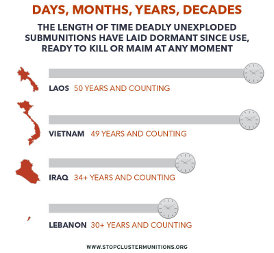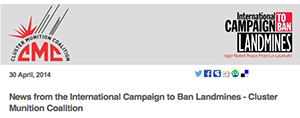Use of cluster bombs
Cluster munitions have been used by over 20 states during armed conflict in over 35 countries.
A timeline of cluster bomb use
Details on all instances of use are available through the Cluster Munition Monitor and in individual country profiles.
- 2012–2018 in Syria:
The government has denied possessing or using cluster munitions, but its armed forces are responsible for the bulk of the more than 630 cluster munition attacks recorded from 2012 to mid-2018. - 2015-2018 in Yemen:
The armed coalition led by Saudi Arabia used cluster bombs repeatedly in populated areas in 2015-2017. In 2018, cluster munition attacks were probably ongoing but were more difficult to record and confirm, due to challenges in collecting first-hand evidence. Human Rights Watch, Amnesty International, and others have documented evidence of at least 23 cluster munition attacks during the conflict. - 2015 in Sudan:
Cluster munitions were used by the Sudanese air force in the Nuba Mountains (South Kordofan) during indiscriminate bombings on civilian areas in February and March 2015. There have been additional reports of use in May 2015. The government of Sudan should investigate and explain these incidents, as requested by the UN Security Council on 29 June 2015. - 2014-2017 in Libya:
There is confirmed evidence that cluster munitions were used in at least two instances between December 2014 and March 2015, in Sirte and Bin Jawad, and additional unconfirmed reports of use on the Watiya front. The commander of the air force of the internationally recognized government of Libya has denied using cluster munitions. In 2016 and 2017, evidence continued to emerge indicating that Libyan National Army forces were using cluster munitions. - 2014 & 2015 in Ukraine:
Cluster munitions were used by both sides to the conflict in January and February 2015. An OSCE mission documented use by Ukrainian government forces in Luhansk city in late January 2015, while Ukrainian government forces had already used cluster munitions in Donetsk city in October 2014. In August 2014, remnants of cluster munitions were documented in territory controlled by Ukrainian government forces and in territory controlled by armed insurgents. As early as July 2014, evidence indicated cluster munitions had been used. - 2014 in South Sudan:
In February 2014 the UN Mine Action Service (UNMAS) found new cluster munition contamination near the town of Bor on the road to Juba. In September 2014 South Sudan reported to the 5th Meeting of States Parties to the Convention that an investigation conducted jointly with UN officials had not been able to determine who had used the weapon. Both South Sudan and Uganda have denied use. - Ongoing since 2012 in Syria:
The use of cluster munitions in the Syrian conflict started in 2012. - 2012 in Sudan:
Two allegations of cluster munition use by the armed forces of Sudan in South Kordofan. Remnants and evidence were found. - 2011 in Libya:
Gaddafi’s forces use cluster munitions in Misrata, Libya. - 2011 in Cambodia:
Thailand uses cluster munitions on Cambodian territory during a border conflict in February 2011. - 2008 in Georgia:
Russia uses several types of cluster munitions, both air- and ground-launched, in a number of locations in Georgia’s Gori district. Also Georgia uses cluster munitions in the August 2008 conflict with Russia. - 2006 in Israel:
Hezbollah fires more than 100 Chinese-produced Type-81 122mm cluster munition rockets into northern Israel. - 2006 in Lebanon:
Israeli forces use surface-launched and air-dropped cluster munitions against Hezbollah. The UN estimates that Israel used up to 4 million submunitions. - 2003–2006 in Iraq:
The US and UK use nearly 13,000 cluster munitions containing an estimated 1.8 to 2 million submunitions in the three weeks of major combat. A total of 63 CBU-87 bombs were dropped by US aircraft between May 1, 2003 and August 1, 2006. - In Uganda, date of use unknown:
RBK-250/275 bombs and AO-1SCh submunitions found in the northern district of Gulu. - 2001–2002 in Afghanistan:
The US drops 1,228 cluster bombs containing 248,056 bomblets. - 1999 in Yugoslavia (including Serbia, Montenegro,and Kosovo):
The US, UK, and Netherlands drop 1,765 cluster bombs, containing 295,000 bomblets. - 1998–2003 in DR Congo:
BL-755 bombs used by unknown forces in Kasu village in Kabalo territory. - 1998–1999 in Albania:
Yugoslav forces launch cross-border rocket attacks and NATO forces carry out six aerial cluster munition strikes. - 1998 in Ethiopia/Eritrea:
Ethiopia and Eritrea exchange aerial cluster munition strikes, Ethiopia attacking the Asmara airport and Eritrea attacking the Mekele airport. Ethiopia also dropped BL-755 bombs in Gash-Barka province of western Eritrea. - 1998 in Colombia:
The Colombian Air Force used a cluster munition in SantoDomingo, a village in the department of Arauca. In 2009, Colombia disclosed that previously it had used cluster munitions on other occasions to attack airfields used by drug traffickers. - 1997 in Sierra Leone:
Nigerian ECOMOG peacekeepers use Beluga bombs on the eastern town of Kenema. - 1996–1999 in Sudan:
Sudanese government forces use air-dropped cluster munitions in southern Sudan, including Chilean made PM-1 submunitions. - 1995 in Croatia:
On May 2-3, 1995, an NSAG uses Orkan M-87 multiple rocket launchers to attack civilians in Zagreb. Additionally, the Croatian government claimed that Serb forces used BL-755 bombs in Sisak, Kutina, and along the Kupa River. - 1994–1996 in Chechnya:
Russian forces use cluster munitions against NSAG. - 1992–1997 in Tajikistan:
Use by unknown forces in civil war. ShOAB and AO-2.5RT submunitions have been found in the town of Gharm in the Rasht Valley. - 1992–1995 in Bosnia & Herzegovina: Forces of Yugoslavia and NSAG use available stocks of cluster munitions during civil war. NATO aircraft drop two CBU-87 bombs.
- 1992–1994 in Nagorno-Karabakh:
Submunition contamination has been identified in at least 162 locations. Submunition types cleared by deminers include PTAB-1, ShOAB-0.5, AO-2.5. - 1992–1994 in Angola:
PTAB submunitions found in various locations. - 1991 in Iraq, Kuwait, Saudi Arabia:
The US and its allies (France, Saudi Arabia, UK) drop 61,000 cluster bombs containing some 20 million submunitions. The number of cluster munitions delivered by surface-launched artillery and rocket systems during the Gulf War is not known, but an estimated 30 million or more DPICM submunitions were used in the conflict. - 1986–1987 in Chad:
French aircraft drop cluster munitions on a Libyan airfield at Wadi Doum. Libyan forces also used AO-1SCh and PTAB-2.5 submunitions. - 1982 in Falkland Islands (Malvinas):
UK aircraft drop cluster munitions on Argentinean infantry positions near Port Stanley, Port Howard, and Goose Green. - 1982 in Lebanon:
Israel uses cluster munitions against Syrian forces and NSAG in Lebanon. - 1979–1989 in Afghanistan:
Soviet forces make use of air-dropped and rocket-delivered cluster munitions. NSAG also use rocket-delivered cluster munitions on a smaller scale. - 1978 in Lebanon:
Israel uses cluster munitions in southern Lebanon. - 1971–1973 in Syria:
Israel uses air-dropped cluster munitions against non-state armed group (NSAG) training camps near Damascus. - 1975–1988 in Western Sahara:
Moroccan forces use cluster munitions against NSAG. - 1960s–1970s in Cambodia, Laos, Vietnam:
US forces make extensive use of cluster munitions in bombing campaigns. The ICRC estimates that in Laos alone, 9 to 27 million unexploded submunitions remain, and some 11,000 people have been killed or injured, more than 30 percent of them children. An estimate based on US military databases states that 9,500 sorties in Cambodia delivered up to 87,000 air-dropped cluster munitions. - 1943 in United Kingdom:
German aircraft drop more than 1,000 SD-2 butterfly bombs on the port of Grimsby. - 1943 in USSR:
Soviet forces use air-dropped cluster munitions against German armour. German forces use SD-1 and SD-2 butterfly bombs against artillery on the Kursk salient.
In addition, unconfirmed reports cite use of cluster munitions in Egypt, Myanmar, Pakistan, Slovenia, Turkey, Sudan, as well as in the territory of Kashmir.



